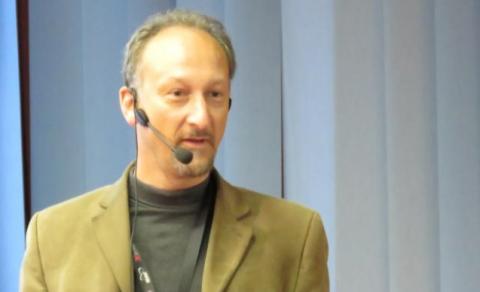
European research and education community GÉANT operates a pan-continental network that transfers more than 1000 terabytes of data each day for its 50 million-plus users at 10,000 institutions.
The IP backbone network operates at up to 500Gbit/s and reaches more than 100 national networks worldwide. Through interconnections with 38 national research and education network (NREN) partners, the GÉANT network is considered one of the largest and most advanced research and education networks in the world. Since it was established more than two decades ago, the GÉANT network has undergone many technological advances. Since 2006, Guy Roberts has been at the helm of some changes. As senior network architect he is responsible for introducing new transmission technology; currently he's focused on reducing costs by using Open Line Systems and Data Center Interconnect (DCI) equipment. Recently, Roberts -- who will speak at NGON & DCI Europe 2018 -- chatted with Broadband World News contributor Logan Armendone-Mowbray about 5G, Internet of Things (IoT), the latest cloud services, open line systems and much more. Read on for an edited version of the conversation:
Broadband World News: Tell us a bit more about what you do and your current projects.
Guy Roberts: We are undergoing a major network expansion over the next four years. We plan to extend our optical fiber footprint to reach most European countries. Combined with traffic growth and expectations of price erosion we need new optical network architecture to deliver this in a cost-effective way. We are leveraging DCI technology by disaggregating the digital and optical parts of the DWDM layer of our network. We have recently chosen Coriant Groove G30 to do this and increase our network capacity. This rollout will begin in the third quarter of 2018.
BBWN: Does fiber play any role here?
GR: GÉANT is also part of a community of European national research networks. We are working with our NREN partners to deploy extensive alien wave (spectrum sharing) solutions to reduce where possible duplication of dark fiber links in Europe. This collaboration is resulting in new ways of working, in particular the introduction of DCI technology is expediting this spectrum sharing.
BBWN: What’s the impact of 5G, IoT and new cloud services on optical networking space?
GR: 5G and IoT have little direct impact on GÉANT as we rely on our regional and university partners to connect to users. It’s too early to say how this will affect our traffic volumes, but we expect the transition to mobile access will continue to push up capacity requirements. The largest part of capacity growth in GÉANT over the past 12 months has been from our big science users such as CERN European Organization for Nuclear Research).
BBWN: How do Open Line Systems affect network costs?
GR: Our analysis shows that, under the right conditions, DCI will allow us to deliver 100Gbit/s services at a cost reduction of up to 90% compared to traditional carrier grade DWDM equipment. However, there are several considerations to keep in mind. The carrier grade DWDM performance gained from using GMPLS restoration is not available on DCIs. Also, we need to upgrade our line system to an OLS by implementing ROADMs in our network. The costs of this upgrade are significantly out-weighed by the cost savings of using DCIs; however this system investment will impact costs in the short-term. We see some very competitive pricing in the line system technology, but many vendors are insisting on licencing fees for the use of alien waves, so we need to be careful to account for this cost when considering the total cost of an OLS upgrade.
BBWN: What are your views on disaggregation and integration? Which one do you think presents an opportunity for the optical networking industry?
GR: For me disaggregation in optical networking is about separating the digital and optical parts of DWDM, i.e. DCI and OLS. The DCI technology is relatively simple to manage as it is, in effect, not much more than a media converter from 100G b&w interface to 100G DWDM. Configuration just requires setting the DWDM side transmission wavelength and power. This is not complex. We plan to continue to use our line system provider’s NMS for OLS management. In this model integration of the two disaggregated layers is straightforward. To keep this simple we intend to keep the DWDM optical layer relatively static -- circuits are unlikely to use on-demand provisioning. We see on-demand circuit delivery as the role of L2 of the network.
The opportunity here for the optical networking industry is that low-cost data center technology is driving down the cost of building networks which will help stimulate demand and increase equipment volumes. It is too early to know if DWDM pluggables will move in large quantities out of transponders/DCI equipment and start being used directly in routers/switches. Certainly Cisco/Juniper would like to see this, but it’s not a model that GÉANT is taking up yet as we see router backplane real estate as too expensive for the low density DWDM interfaces currently available.
Furthermore, there will be an opportunity for network management integration between DCI and OLS. It is not clear if the trend will be towards single vendor solutions to allow for management integration or if third party integrators will pick up the integration role. In the short term GÉANT will take on the responsibility for WDM integration ourselves.
BBWN: How will disaggregation impact the optical network and DCI market?
GR: I expect the traditional carrier-grade DWDM equipment vendors will be under considerable pressure over the next few years. How they adjust their business models to account for the lower revenues from transponders will determine their future. There is, however, a much better outlook for network providers. GÉANT expects to make considerable savings to our equipment revenues over our next four-year funding cycle.
Source:
http://www.broadbandworldnews.com/document.asp?doc_id=742883